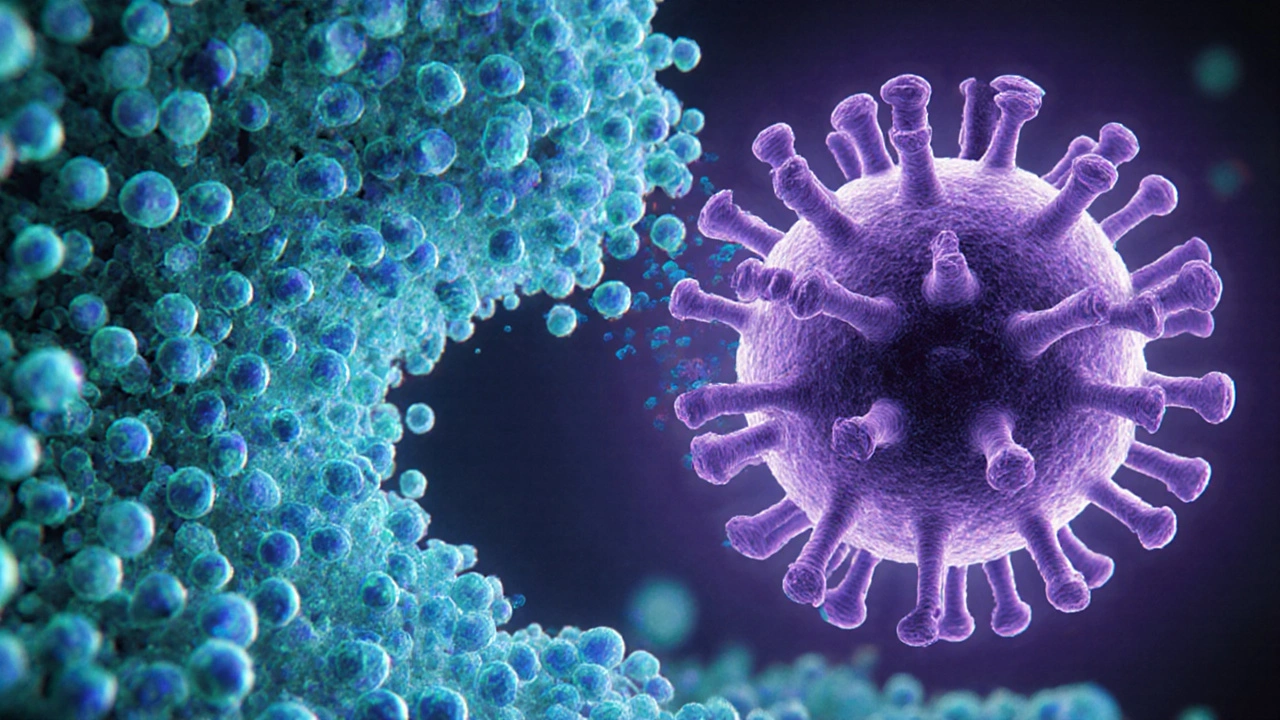wart vaccine is a form of immunotherapy that prompts the body’s immune system to target the virus causing common skin warts. While the idea sounds futuristic, doctors have been using several existing vaccines off‑label for years to clear stubborn warts. If you’re tired of endless cryotherapy sessions or salicylic acid pads, the wart vaccine might be a game‑changer worth exploring.
Key Takeaways
- Wart vaccines harness the immune system, offering up to 70% clearance in clinical studies.
- HPV, MMR, and BCG vaccines are the most frequently repurposed for wart treatment.
- Side effects are generally mild-mainly injection site soreness and low‑grade fever.
- Costs vary widely; insurance may cover off‑label use if a dermatologist recommends it.
- Best candidates are adults with persistent, hard‑to‑treat warts after conventional methods fail.
How Wart Vaccines Work
Warts are caused by human papillomavirus (HPV), a virus that hides inside skin cells and forces them to grow into the raised bumps we all dread. The body’s natural defense often takes months or years to recognize the virus, which is why warts can linger.
Vaccines like the HPV vaccine contain harmless fragments of the virus (or a related virus) that train immune cells-especially T‑cells-to spot and attack infected cells. When injected directly into or near a wart, the immune system gets a clear “red flag” and launches a targeted response, clearing the lesion faster than it would on its own.
Popular Off‑Label Vaccines for Warts
Three vaccines dominate the off‑label wart‑treatment landscape:
- HPV vaccine (e.g., Gardasil, Cervarix) - originally created to prevent cervical cancer, it contains virus‑like particles that mimic the strains causing skin warts.
- MMR vaccine (measles, mumps, rubella) - shares viral proteins that cross‑react with certain wart‑causing HPV types.
- BCG vaccine (tuberculosis) - a live‑attenuated vaccine that boosts non‑specific immune activity, helpful for stubborn plantar warts.
Doctors typically inject a small dose directly into the wart (intranodular injection) or into the surrounding skin. The procedure takes only a few minutes and can be repeated every 2-4 weeks until the wart fades.
What the Evidence Says
Several small‑scale trials and observational studies have measured success rates. A 2022 meta‑analysis of 12 studies involving over 800 patients reported an average clearance rate of 68% for HPV‑based wart immunotherapy, compared with 31% for placebo or no treatment.
MMR and BCG show slightly lower but still noteworthy results-around 55% and 48% respectively. Importantly, the studies highlight faster clearance for facial warts and non‑painful lesions, while plantar warts often need more sessions.
Researchers also note a “boost” effect: patients who receive a vaccine injection often experience clearance of nearby warts that weren’t directly treated, suggesting a systemic immune response.
Comparing Wart Vaccines to Traditional Treatments
| Treatment | Mechanism | Typical Success Rate | Side Effects | Average Cost (USD) |
|---|---|---|---|---|
| HPV‑based wart vaccine | Immune‑system priming via viral antigens | 60‑70% | Injection site soreness, mild fever | 150‑300 per session |
| MMR/BCG vaccine | Non‑specific immune activation | 45‑55% | Soreness, rare ulceration | 100‑250 per session |
| Cryotherapy | Freezing with liquid nitrogen | 30‑50% | Pain, blistering, pigment changes | 75‑150 per session |
| Salicylic acid | Keratin dissolution over weeks | 25‑35% | Skin irritation, dryness | 5‑20 for OTC products |
| Laser therapy | Targeted ablation of wart tissue | 55‑65% | Pain, scarring, pigment loss | 300‑600 per session |
When you stack the numbers, wart vaccines sit near the top for overall clearance while offering fewer cosmetic side effects than cryotherapy or laser. The trade‑off is a higher upfront cost and the need for a qualified dermatologist to administer the injection.

Safety Profile and Possible Side Effects
Because these vaccines are already approved for other uses, their safety data are robust. The most common reactions are limited to the injection site-redness, swelling, and a mild ache lasting 1‑2 days. Systemic symptoms like low‑grade fever occur in roughly 10% of patients and resolve without medication.
Serious adverse events (e.g., anaphylaxis) are exceedingly rare and usually linked to known vaccine allergies. Before treatment, clinicians screen for prior severe reactions to any of the three vaccines.
Cost, Insurance, and Accessibility
Pricing varies by region and whether the vaccine is used on‑label. In the United States, an HPV vaccine dose costs about $150‑$200, while MMR and BCG are cheaper but may still be billed as an off‑label procedure. Some insurance plans cover the injection if a dermatologist documents medical necessity-especially when conventional therapies have failed.
In South Africa, public health clinics often stock the BCG vaccine for tuberculosis, making it a more affordable option for wart treatment. Private dermatology practices may charge a procedural fee on top of the vaccine cost.
Who Should Consider a Wart Vaccine?
Ideal candidates share a few characteristics:
- Persistent warts lasting longer than 12 months despite at‑home or clinical attempts.
- Warts located on the face, neck, or genital area where scarring from cryotherapy is a concern.
- Patients with a history of mild vaccine tolerance (no severe allergies).
- Individuals seeking a systemic approach that could clear multiple lesions at once.
Children under 5 generally aren’t recommended for off‑label wart vaccines because their immune systems respond differently, and the risk‑benefit ratio isn’t well studied.
Talking to Your Dermatologist
Bring these questions to your next appointment:
- Which vaccine do you recommend for my specific wart type?
- How many injection sessions will I likely need?
- Will my insurance cover the off‑label use?
- What should I expect in terms of pain and downtime?
- Are there any contraindications based on my medical history?
A clear, collaborative discussion helps you weigh the benefits against costs and potential side effects, ensuring you make an informed choice.
Next Steps & Troubleshooting
If you decide to try a wart vaccine, follow these practical steps:
- Schedule a consultation with a board‑certified dermatologist.
- Ask for a written treatment plan that outlines vaccine type, dosage, and follow‑up schedule.
- Monitor the treated area for any unusual swelling or prolonged redness-report these to your doctor.
- If the wart persists after three sessions, discuss alternative options such as laser therapy or surgical excision.
Remember, no single treatment works for everyone. Combining a wart vaccine with gentle skin‑care (moisturizers, avoiding picking) often yields the best results.

Frequently Asked Questions
Can the HPV vaccine prevent warts on the hands and feet?
The standard HPV vaccine is licensed to prevent genital warts, but off‑label studies show it can stimulate immunity against the same virus strains that cause common and plantar warts. Success rates are highest for facial warts and lower for thick plantar lesions.
Is the injection painful?
Most patients describe a brief pinch, similar to a flu shot. The soreness typically fades within 24‑48 hours. Topical lidocaine cream can be applied beforehand to reduce discomfort.
How many sessions are usually needed?
Clinicians often start with 2‑3 injections spaced 3 weeks apart. If the wart shrinks but hasn’t disappeared, a fourth session may be scheduled. Most patients see noticeable improvement after the first two visits.
Will the vaccine affect other warts on my body?
Yes, many reports describe a "bystander effect" where untreated warts regress after the immunotherapy, indicating a systemic immune boost.
Are there any long‑term risks?
Long‑term safety data are reassuring because the vaccines have been in use for decades. The biggest concern is applying them to patients with compromised immune systems, where a specialist’s oversight is essential.
